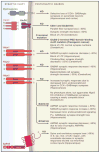Synaptic Neurexin Complexes: A Molecular Code for the Logic of Neural Circuits
- PMID: 29100073
- PMCID: PMC5694349
- DOI: 10.1016/j.cell.2017.10.024
Synaptic Neurexin Complexes: A Molecular Code for the Logic of Neural Circuits
Abstract
Synapses are specialized junctions between neurons in brain that transmit and compute information, thereby connecting neurons into millions of overlapping and interdigitated neural circuits. Here, we posit that the establishment, properties, and dynamics of synapses are governed by a molecular logic that is controlled by diverse trans-synaptic signaling molecules. Neurexins, expressed in thousands of alternatively spliced isoforms, are central components of this dynamic code. Presynaptic neurexins regulate synapse properties via differential binding to multifarious postsynaptic ligands, such as neuroligins, cerebellin/GluD complexes, and latrophilins, thereby shaping the input/output relations of their resident neural circuits. Mutations in genes encoding neurexins and their ligands are associated with diverse neuropsychiatric disorders, especially schizophrenia, autism, and Tourette syndrome. Thus, neurexins nucleate an overall trans-synaptic signaling network that controls synapse properties, which thereby determines the precise responses of synapses to spike patterns in a neuron and circuit and which is vulnerable to impairments in neuropsychiatric disorders.
Copyright © 2017. Published by Elsevier Inc.
Figures






References
-
- Arac D, Boucard AA, Ozkan E, Strop P, Newell E, Sudhof TC, Brunger AT. Structures of neuroligin-1 and the neuroligin-1/neurexin-1 beta complex reveal specific protein-protein and protein-Ca2+ interactions. Neuron. 2007;56:992–1003. - PubMed
Publication types
MeSH terms
Substances
Grants and funding
LinkOut - more resources
Full Text Sources
Other Literature Sources
Molecular Biology Databases
Miscellaneous

